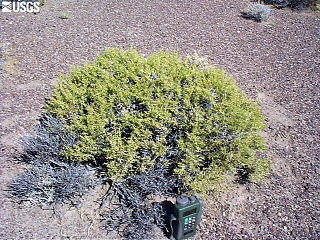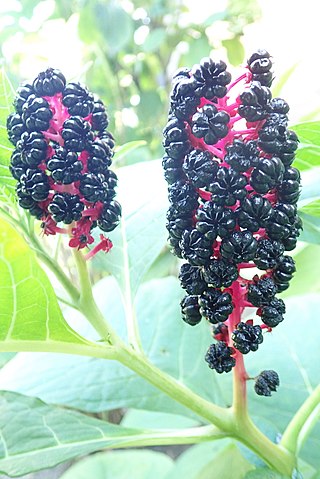
Sarcobatus is a North American genus of two species of flowering plants, formerly considered to be a single species. Common names for S. vermiculatus include greasewood, seepwood, and saltbush. Traditionally, Sarcobatus has been treated in the family Chenopodiaceae, but the APG III system of 2009 recognizes it as the sole genus in the family Sarcobataceae.

Stegnosperma is a genus of flowering plants, consisting of three species of woody plants, native to the Caribbean, Central America, and the Sonoran Desert. These are shrubs or lianas, with anomalous secondary thickening in mature stems, by successive cambia.

Barbeuia madagascariensis is a liana found only on the island of Madagascar.

Phytolaccaceae is a family of flowering plants. Though almost universally recognized by taxonomists, its circumscription has varied. It is also known as the Pokeweed family.

Heliodinidae, commonly known as sun moths, is a family of small moths with slender bodies and narrow wings. Members of this family are found in most parts of the world. Heliodinid moths are brightly coloured day-flying moths. The base of the haustellum is bare. The scales on the head are compact and appear like a shield. Many Heliodinidae raise their hindlegs when resting but this is not a taxonomic feature and several genera like Epicroesa and Lamprolophus do not show this posture. Many Heliodinidae have the inner and outer spurs of the metatibia subequal. The larval host plants of the majority of species are in the Aizoaceae, Chenopodiaceae, Phytolaccaceae, Portulacaceae and Nyctaginaceae, all in the Order Caryophyllales. A few feed on Onagraceae, Araliaceae and Piperaceae. The pupae have long stiff hairs on their back sides.

Caryophyllales is a diverse and heterogeneous order of flowering plants that includes the cacti, carnations, amaranths, ice plants, beets, and many carnivorous plants. Many members are succulent, having fleshy stems or leaves. The betalain pigments are unique in plants of this order and occur in all its families with the exception of Caryophyllaceae and Molluginaceae.

Petiveriaceae is a family of flowering plants formerly included as subfamily Rivinoideae in Phytolaccaceae. The family comprises nine genera, with about 20 known species.

Phaulothamnus is a genus of plants formerly included in the family Phytolaccaceae but now considered a part of the Achatocarpaceae.
Ercilla is a genus of plants in the Phytolaccaceae family containing three species: Ercilla volubilis, Ercilla spicata, and Ercila syncarpellata.

Microtea, the jumby peppers, are a genus of flowering plants in the family Microteaceae, native to the Caribbean islands, Central America, and South America.

Phytolacca acinosa, the Indian pokeweed, is a species of flowering plant in the family Phytolaccaceae. It is native to temperate eastern Asia; the Himalayas, most of China, Vietnam to Japan, and has been widely introduced to Europe. The species was originally described by William Roxburgh in 1814.
Schindleria is a genus of flowering plants in the family Petiveriaceae.
Atriplex codonocarpa, the flat-topped saltbush, is a species of flowering plant in the family Amaranthaceae, native to Western Australia. It is often found growing on the outer edges of salt lakes.

Maireana carnosa, the cottony bluebush, is a species of flowering plant in the family Amaranthaceae, native to western and central Australia. It is typically found growing in heavy soil, often on the verges of salt lakes.

Maireana ciliata, the fissure weed, is a species of flowering plant in the family Amaranthaceae. It is native to Australia, and has been introduced to South Africa. A decumbent perennial usually only reaching 10 cm (4 in) high, it is typically found growing in deserts or dry shrublands.
Maireana convexa, the mulga bluebush, is a species of flowering plant in the family Amaranthaceae, native to Western Australia. It is usually found growing in non-saline soils in the mulga habitat.
Maireana excavata, the bottle bluebush, is a species of flowering plant in the family Amaranthaceae, native to southeastern Australia. A decumbent perennial with a substantial taproot, it is typically found growing in heavy soils.
Maireana glomerifolia, the ball-leaf bluebush, is a species of flowering plant in the family Amaranthaceae, native to Western Australia. It is typically found in dry, saline areas.
Maireana planifolia, the low bluebush, is a species of flowering plant in the family Amaranthaceae, native to western and central Australia. It is found in a wide variety of situations, including sandy areas, rocky slopes, and in the mulga habitat.
Maireana suaedifolia, the lax bluebush, is a species of flowering plant in the family Amaranthaceae, native to Western Australia and South Australia. It is typically found growing in alluvial plains or on sand dunes.











